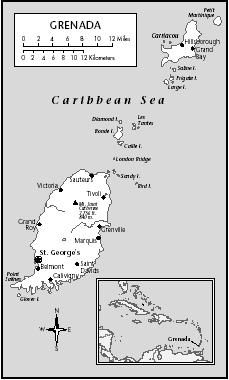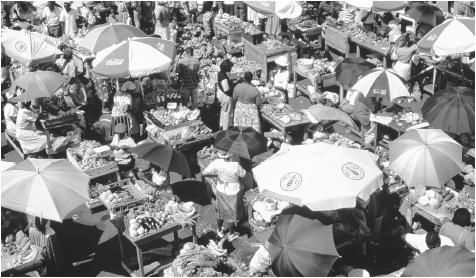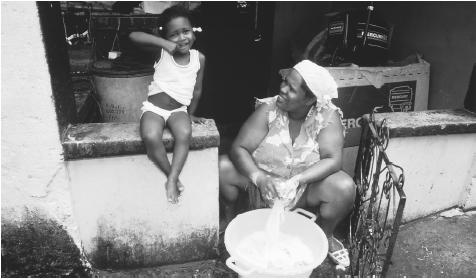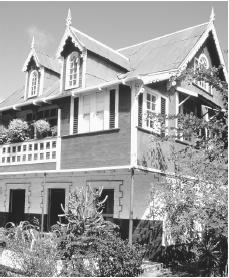Grenada
Culture Name
Grenadian
Orientation
Identification. The Carib Indians violently displaced the Arawak (Taino) tribes around 1000 C.E. and called the island Camerhogne, until they also were driven out. In 1300, Alonso de Hojeda, Amerigo Vespucci, and Juan de la Cosa named the island Mayo while on a mapping mission. Christopher Columbus named the island Concepción when he spotted it in 1498. The name "Granada" was used on maps until the mid-1600s. To the French, the island was known as La Grenade; to the English, Grenada became the permanent title in 1763.
Location and Geography. Grenada is an island of volcanic origin in the Lesser Antilles chain ninety miles north of Venezuela. Grenada measures fourteen miles across and twenty-six miles top to bottom for a total land area of 121 square miles—133 square miles when Carriacou and Petit Martinique are included. Dense rain forest, a jagged coastline, picturesque beaches, and brilliant foliage are enhanced by a mild climate. The wet season lasts from July through September, and the dry season lasts from October through June. Rainfall can be quite heavy but generally does not last long. Grenada's southern position protects it from hurricanes. The capital is Saint George's.
Demography. The population of Grenada was 97,008 in the year 2000, with more than 42 percent of the people under age fifteen and 4 percent over age sixty-five. The youth of the population is reflected in the growing popularity of Western culture and the slow disintegration of the traditional culture. Only a few elderly people in the countryside can speak the French-based Creole (in patois, Kweyol ) language. However, literary circles are campaigning to expose schoolchildren to the Creole language. Forty-four percent of the population lives outside the urban areas. Saint George's has a population of 4,439.
Linguistic Affiliation. The official language is Standard English—patois is very rarely spoken today. Attempts to revive the French-based patois have not been successful.
Symbolism. The common symbol, which appears on the flag and drives the economy, is nutmeg. As the major export and job provider, nutmeg is an integral part of island life. The flag also displays seven stars in yellow on a red background. Six of the stars are positioned around the flag's border and represent the six parishes named for Saints David, Andrew, Patrick, Mark, John, and Paul. A single star in the center stands for Saint George's Borough, where the capital is located. Nutmeg appears in a field of green to the left of the flag's center. The colors were selected to reflect the natural beauty of the island and the characteristics of its people. Red stands for courage and vitality, yellow represents wisdom and warmth, and green represents agriculture and the island's rich vegetation. These are also the colors of the Rastafarian religion.
History and Ethnic Relations
Emergence of the Nation. The earliest settlers migrated from the Amazonian basin of South America. This Amerindian descent is still evident in the northern countryside where pottery and other Indian crafts are made with traditional methods. Eighty-two percent of the inhabitants are of African origin, descendants of the African slaves who were brought to work the European-owned plantations. Five percent of the people are descended from Asian Indians also brought to the island as indentured servants. The remaining 13 percent of the people are of mixed ancestry, including European and American immigrants.
Long before Columbus sighted the island, the Amazonian Indians had established a tradition of

As early as 1700, slaves and a small number of "Free Coloureds" outnumbered white Europeans almost two to one. In the Fedon Rebellion of 1795, Free Coloureds and slaves gathered in an unusual display of disregard for social segregation. In 1974, Grenada gained independence.
National Identity. Grenadians are protective of a local culture that has resulted from a long history of identity crisis. European customs remain an integral part of daily life. Law enforcement officers hold the title of Her Majesty's Royal Police, British spelling is taught in schools, and the Eastern Caribbean dollar displays the queen of England. Many names of streets, rivers, bays, and villages reflect the years of French occupation, along with styles of architecture and food.
Ethnic Relations. Grenada shares a common Caribbean culture base with many other islands in the Lesser Antilles, including music, literature, greetings and salutations, food, and family structure. Not unlike the United States, ethnic groups remain somewhat segregated on Grenada. East Indian families uphold traditions and community ties, as do the African Caribbean island majority. East Indians are viewed by some to own a disproportionately high number of businesses on the island and pay a disproportionately low wage. Stereotypes are changing, however, as the ethnic groups mix and inter-marry.
Urbanism, Architecture, and the Use of Space
In the larger and older communities, the legacy of French and British occupation is clearly visible. The architectural styles reflect a strong European influence but have been modified by bright colors and decorative accessories such as hollow eggshells placed on the tips of a cactus branch. Windows are the essential element of residential or commercial buildings. Schools often do not have windows but instead have large open frames that can be battened down during storms. Buildings are designed to take advantage of the Caribbean breeze while providing shelter from the intense sunlight.
Food and Economy
Food in Daily Life. Staples such as bread, rice and peas, fruits, and vegetables figure prominently in the diet. Cocoa tea made from local cocoa and spices is a popular breakfast drink. Lunch is usually a heavier meal that may include salted cod in a "bake," which is fried bread about the size and shape of a hamburger bun. Fish is plentiful and affordable, as is chicken. Beef is scarce. Pork is reserved for special occasions such as Christmas, while goat and lamb are eaten commonly. Dishes are seasoned heavily with local spices. The national dish, "oil down," is a stew-like concoction made in large quantities with local vegetables such as callalou, dasheen, breadfruit, green fig (banana), and plantain. Pig snout, pig tail, salt mackerel, crab, and "back and neck" of chicken are popular additions. The boullion is a mixture of coconut milk, saffron, water, and seasonings.
Food Customs at Ceremonial Occasions. Meals are social occasions, and holidays such as Christmas are spent visiting family, friends, and neighbors, with small "meals" eaten at each stop. Beef, spice cakes, and guava cheese are popular fare. Foods such as ham are expensive and often reserved for just the very important holidays, such as Christmas. Boudin, or blood sausage, is also a holiday favorite, along with a sweet ground cornmeal cake, which is cooked in the wrapped leaves of the banana tree and served tied with a string like a little gastronomic gift. A shot of local rum or creamy rum grog is a traditional accompaniment.
Basic Economy. The currency is the Eastern Caribbean Dollar. Approximately 2.68/2.70 Eastern Caribbean dollars are equivalent to one U.S. dollar. Basic foods are readily available, with the possible exception of grains. Other than nutmeg, virtually all other products are imported. Tourism is growing rapidly.
Land Tenure and Property. Because of the presence of unmonitored squatters in rural areas, the government has been hampered in its actions unless a development prospect is likely. Primitive shacks lack electricity and running water. When these communities grow into villages, programs may be implemented to offer the land for sale at a discounted rate.
Commercial Activities. The economy is driven by nutmeg and tourism. Other spices are produced for local consumption and export, including mace, cinnamon, and cloves.
Major Industries. The major industry is the production of textiles, although they are produced in relatively small amounts by industrial standards. Batik, or hand-designed waxed cloth, is a popular industry for tourism, but not widely worn by the local population.
Trade. The majority (32 percent) of goods are exported to other Caribbean island nations. Another 20 percent of exports goes to the United Kingdom. Virtually everything except perishable food is imported, including, but not limited to, electronics, automobiles, appliances, clothing, and non-perishable foods. Imports come mainly (32 percent) from the United States.
Division of Labor. Service industries account for 29 percent of the labor force, followed by agriculture with 17 percent and construction with 17 percent.
Social Stratification
Classes and Castes. Wealthy areas are inhabited by a disproportionate number of resident foreigners. This situation has led the government to impose stricter regulations on foreign investment and the immigrant population.
Symbols of Social Stratification. Class often is measured by the number of modern conveniences one has. In more rural areas, a concrete "wall" house with modern amenities may stand next to a corrugated shack where a family of six uses an outdoor pipe as its only water source. When the children from these houses leave for school in the morning, it is nearly impossible to distinguish their class origins. School children wear mandatory uniforms that are impeccably maintained even by the poorest households.
Political Life
Government. Grenada is a parliamentary democracy headed by the prime minister who heads the ruling party and the government, which is composed of thirteen appointed senators and fifteen elected members of the House of Representatives. As a member of the British Commonwealth, Grenada has a governor general who is appointed by the British monarch.
Leadership and Political Officials. Adults still have sharp recollection of the revolution of 1979 and the violent circumstances that preceded that upheaval. Protests just before the overthrow of the Eric Gairy government began at the grassroots level and enlisted schoolchildren to march in protests and demonstrate through sit-ins.
Because of the small size of the island, it is common for the majority of constituents to know their local government representatives. Politicians are accessible to the public and are expected to uphold their campaign promises. While the major political figures live in secure and luxurious housing,

Social Problems and Control. The rate of violent crime on Grenada is low. Common crimes include petty theft, trespassing, and drug infractions. Prison does not confer great social stigmatism, and exconvicts are readily integrated back into their communities unless the crime was violent or sexual.
Military Activity. The military budget is small. Law enforcement officers often are trained in other countries to gain military expertise.
Social Welfare and Change Programs
Organizations from the United Kingdom, Canada, the United States, and neighboring Caribbean countries assist with child care, education, teacher training, health, and human rights.
Nongovernmental Organizations and Other Associations
Nongovernmental organizations and other associations provide everything from medical supplies to textbooks. Among the more visible groups are the Rotary Club, Save the Children, Crossroads, Peace Corps, Grenada Education (GRENED), Programme for Adolescent Mothers, and the New Life Organisation.
Gender Roles and Statuses
Division of Labor by Gender. Women are beginning to dominate professions such as banking while maintaining a presence in banana fields and at nutmeg processing stations. Financial necessity forces women to support their families. Women are still expected to perform traditional household duties such as cleaning and laundry. Men hold traditional jobs in construction, mechanics, and shipping in which it is unheard of to hire women.
The Relative Status of Women and Men. While women work in politics and professional trades, men are still socially dominant. Typically, after a husband and wife have finished work, the man unwinds at the local rum shop with his friends while the woman attends to household duties.
Marriage, Family, and Kinship
Marriage. Marriage is a strong institution in this predominantly Catholic country. Men are expected

Domestic Unit. The family is a powerful unit. Houses of all sizes often contain several generations of at least one family. Children are raised by their parents, grandparents, siblings, and aunts and uncles. If a father figure is present, he most likely is the dominant figure in the household.
Inheritance. Land is the principal unit of inheritance and generally passes along the male line. Since a woman is expected to be cared for by her husband, the man benefits most from an inheritance.
Kin Groups. Communities act as kin groups and are closely knit units. Immediate parents commonly go abroad to earn a better wage, leaving even infant children to be raised by extended family members, and thus, in turn, the community. Members of a community support each other through food exchange and resource pooling.
Socialization
Infant Care. Infants are carried by family members until they can maneuver on their own. Quiet and obedient infants are the ideal. There is not a high level of stimulation, and behavior is often modified by corporal punishment, even at a very young age.
Child Rearing and Education. A good child does not speak out of turn, always does his or her chores, and earns high marks in school. At home and in the classroom, corporal punishment is common. The school system does not support the growing number of youths in its population. Children completing primary school must pass a common entrance exam to move on. Even then, there are never enough available places for student demand. The number of children forced to drop out of school as a result has sparked the growing popularity of "alternative" or trade/skill schools.
Higher Education. Education beyond primary or secondary levels is a luxury that few people can afford. Scholarships or a sponsoring relative abroad is often the only way to reach the college level. An American medical school offers two scholarships a year to local residents.
Etiquette
Salutations are an important part of daily etiquette even among strangers. Public displays of affection are common among schoolchildren, particularly

Religion
Religious Beliefs. Grenada is predominantly Roman Catholic (53 percent), with Protestants accounting for 33 percent of the population. Among Christians, a substantial number believe to some extent in obeah , or white magic. Newspapers occasionally report a spirit who has been raised and is haunting some section of the island.
Religious Practitioners. Priests and clergy, as well as obeah agents, are respected for their higher calling or ability to cast a spell.
Rituals and Holy Places. Churches are formidable institutions where the majority of religious ceremonies take place.
Death and the Afterlife. A funeral is a social occasion to honor the deceased with a banquet of food and drink. The Day of the Dead is celebrated by the family and friends of the departed. Food, drink, and music may be brought to the graveyard and enjoyed amid the glow of candles throughout the night.
Medicine and Health Care
Local remedies are sought with great frequency, and herbs and medicinal plants are widely accepted as having healing powers. The island's bio-medical facilities are substandard.
Secular Celebrations
Holidays and celebrations reflect the influence of religion, particularly Roman Catholicism. The most important holiday is Carnival, which traditionally is celebrated on the weekend culminating on Ash Wednesday. Carnival is now celebrated during the second week of August to generate tourism from neighboring islands. It also coincides with Rainbow City, a celebration in the parish of Saint Andrew's that commemorates Emancipation Day. Other major holidays and celebrations include New Year's Day on 1 January, Independence Day on 7 February, Labour Day on 1 May, the Grenada Jazz Festival in June, Fisherman's Day on 29 June, the Carriacou Regatta in July and August, Emancipation Days in August, Thanksgiving on 25 October, and Boxing Day on 26 December.
The Arts and Humanities
Support for the Arts. The arts are supported largely by tourists, expatriates, and islanders.
Literature. Crick-crack stories often include the spider character Anansi and his friends. These stories are similar to fairy tales and have both oral and written traditions. They often are shared in groups, with the storyteller beginning "Crick," and the audience replying "Crack."
Graphic Arts. Paintings include oil, watercolors, and standard other mediums, but what sets Grenadian art apart is the "canvas" used for various paints. Cloth, bamboo, calabash, cutlass, wood, metal, and many other materials can be used by the Grenadian artist as painting surfaces. Ordinary objects beautifully painted with bright Caribbean colors are a common sight. Local art events usually occur in Saint George's because of its accessibility and population of art patrons.
Performance Arts. Drama, dance, and music are popular, and performances sometimes occur during festivals and at small theaters.
The State of the Physical and Social Sciences
Higher education, particularly in the sciences, is not adequate. Tuition costs and fees prevent the majority of Grenadians from attending the American medical school. Cuba and the United Kingdom provide scholarship and exchange programs.
Bibliography
Bendure, Glenda, and Ned Friary. Lonely Planet—Eastern Caribbean , 1998.
Brizan, George. Grenada—Island of Conflict , 1987.
Ferguson, James. A Traveller's History of the Caribbean , 1999.
Froud, J. A. The English in the West Indies , 1888.
Gates, Brian. African Caribbean Religions , 1980.
Groene, Janet. Caribbean Guide , 2000.
Hamlyn, James. Exploring the Caribbean , 2000.
Henderson, James. The Southeastern Caribbean—Windward Islands , 1994.
Kay, Frances. This Is Grenada , 1996.
Knight, F. W., and C. A. Palmer. The Modern Caribbean , 1989.
Lunatta, Karl. The Caribbean: The Lesser Antilles , 1996.
O'Shaughnessey, Hugh. Grenada , 1984.
Parry, J. H., P. M. Sherlock, and Anthony Maingot. A Short History of the West Indies , 1987.
Rogozinski, Jan. A Brief History of the Caribbean , 1992.
Runge, Jonathan. Rum and Reggae, 1995.
Searle, Chris. Grenada: The Struggle against Destabilization , 1992.
Walton, Chelle K. Caribbean Ways: A Cultural Guide , 1993.
—K AREN L YNN P IERZINSKI
G RENADINES S EE S AINT V INCENT AND THE G RENADINES
knowledge for all grenadians at home and abroad
i've gained so much by reading about my country and i hope its a lesson well learnt
thank you
it helped me in my project.
1. St. Paul is a village not a parish , St. George is the parish and the capital St. George's.
2. The seventh star represents the sister isles of Carriacou and Petite Martinique.
3. All schools on the island have shutters as far as I know and that's the way I have always known it .
4. The population has exceeded 100,000.
All in all the extract needs to be updated, for it is not a valid resource of information since a lot of the facts have changed in recent times
just my contribution.
PS: Do they have call center jobs & is it hard to get a Job? How's the cost of living there? How's the process for the work permit? Is it hard to get a work permit? How's the average pay job? If someone can answer these questions I would really appreciate that thanks in advance!!!
PS: Do they have call center jobs & is it hard to get a Job? How's the cost of living there? How's the process for the work permit? Is it hard to get a work permit? How's the average pay job? If someone can answer these questions I would really appreciate that thanks in advance!!! Here's my email address: sousoune31@yahoo.com
I'm writing you from Guadeloupe. I teach English, and as part of our plan, I want my pupils to discouver the national dresses or traditional costumes worn in the Caribbean islands. Would you help me and send any picture you have got in your possession on the subjet or direct me anywhere I can find those pictures.
My pupils and I thank you in advance for your help.
Best regards
the facts are really strong.
plz inbox me with the ans. anyone someone plz